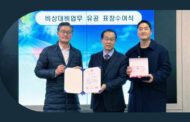A special lecture on the story behind the 2018 Nobel Prize winners in Physics is scheduled to be held at UNIST on October 11, 2018.
Jointly organized by the Department of Physics and the IBS Center for Soft and Living Matters at UNIST, the event invites Professor Hyuk Kyu Pak and Distinguished Professor François Amblard to share their insights on the recent announcement of the Nobel Prize in Physics and their big scientific breakthroughs. During the course of the event, attendees will also have ample opportunity to interact with lecturers and learn more about ‘Optical Tweezers’ and ‘High-Intensity, Ultra-short Laser Pulses’, two groundbreaking inventions in laser physics that won the 2018 Nobel Prize in Physics.
Under the topic of “Why Did They Get The Nobel Prize in Physics? Why Should We Care”, Professor Pak will deliver a speech on “Ashkin: Principle and Applications of Optical Traps”. This will be followed by a lecture on “Strickland and Mourou: How to Produce Ultra-Bright Light? And Why?” by Distinguished Professor Amblard.
The Nobel Prize is the world’s most prestigious award, bestowed in a number of categories by Swedish and Norwegian committees in recognition of cultural and/or scientific advances. This year’s Nobel Prize in Physics went to a trio of optical physicists—Arthur Ashkin, Donna Strickland, and Gérard Mourou—for “[their] groundbreaking inventions in the field of laser physics.”

The 2018 Nobel Prize in Physics winners: Arthur Ashkin, Gérard Mourou, and Donna Strickland I Image Credit: nobelprize.org
Arthur Ashkin, formerly a researcher at Bell Laboratories in Holmdel, New Jersey, won half the prize for his work on ‘optical tweezers‘, while Donna Strickland (University of Waterloo, Canada) and Gérard Mourou (École Polytechnique, France) jointly won the other half for creating technology that generate ‘high-intensity, ultrashort optical pulses‘.
Optical tweezers are beams of light that can manipulate the minutest elements of matter—from atoms to molecules to living cells. The tool is now used to study the inner workings of cells and DNA.
The technique, studied by Mourou of École Polytechnique and Strickland of the University of Waterloo can stretch and amplify beams of light, leading to boosts in laser power. It is now routinely used in medical science, specifically, as the lasers in corrective eye surgery and precision machining.















